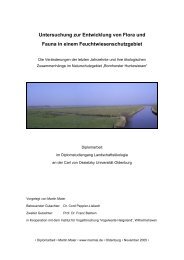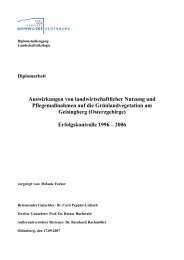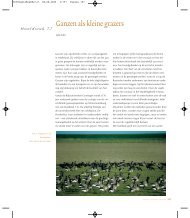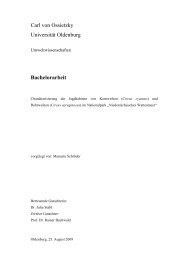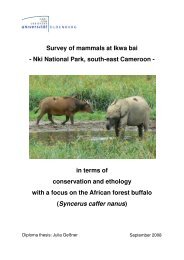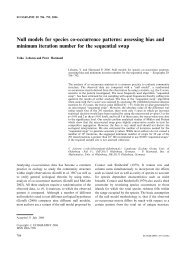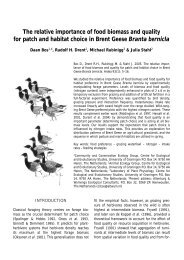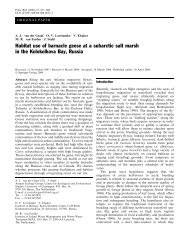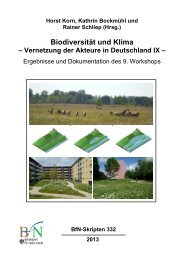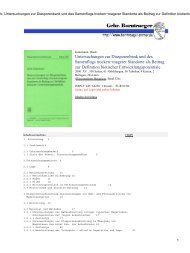The use of habitat models in conservation of rare and endangered ...
The use of habitat models in conservation of rare and endangered ...
The use of habitat models in conservation of rare and endangered ...
You also want an ePaper? Increase the reach of your titles
YUMPU automatically turns print PDFs into web optimized ePapers that Google loves.
250<br />
Multivariate <strong>models</strong><br />
Case study 1<br />
<strong>The</strong> multivariate <strong>habitat</strong> model for V. bensoni<br />
conta<strong>in</strong>ed two significant <strong>habitat</strong> parameters (Table<br />
2). <strong>The</strong> model showed that with both<br />
decreas<strong>in</strong>g nitrogen <strong>in</strong>dicator values <strong>and</strong> decreas<strong>in</strong>g<br />
tree cover the <strong>in</strong>cidence <strong>of</strong> V. bensoni <strong>in</strong>creased<br />
(Figure 1). Model discrim<strong>in</strong>ation was good (Table<br />
2): <strong>in</strong> 85% <strong>of</strong> the plots occurrence <strong>of</strong> V. bensoni<br />
was correctly classified.<br />
Case study 2<br />
<strong>The</strong> f<strong>in</strong>al multivariate <strong>models</strong> for the brownfield<br />
species conta<strong>in</strong>ed three or four (N. m<strong>in</strong>or)<br />
explanatory variables (Table 3). Model performance<br />
measures are given <strong>in</strong> Table 5, coefficients,<br />
st<strong>and</strong>ard errors <strong>and</strong> p-values <strong>in</strong> Table 4.<br />
<strong>The</strong> model for R. vitripennis <strong>in</strong>cluded the<br />
parameters age, moss cover <strong>and</strong> cover <strong>of</strong> Festuca<br />
rubra/ov<strong>in</strong>a. Occurrence probabilities were highest<br />
at medium levels <strong>of</strong> age <strong>and</strong> moss cover (Figure 3).<br />
With <strong>in</strong>creas<strong>in</strong>g cover <strong>of</strong> Festuca, the <strong>in</strong>fluence <strong>of</strong><br />
these parameters became negligible; occurrence<br />
probabilities always exceeded the threshold.<br />
Occurrence <strong>of</strong> N. m<strong>in</strong>or could be expla<strong>in</strong>ed best<br />
with a four-parameter model. Occurrence probabilities<br />
above the threshold were restricted to low,<br />
but non-zero 50%-heights, regardless <strong>of</strong> the other<br />
parameter values (Figure 4). Moderate litter covers<br />
were preferred <strong>in</strong> comb<strong>in</strong>ation with low cover<br />
<strong>of</strong> Corynephorus canescens <strong>and</strong> low proportions <strong>of</strong><br />
Table 2. Case study 1: Multiple <strong>habitat</strong> model <strong>of</strong> the leafhopper<br />
Verdanus bensoni.<br />
Model parameters & coefficients<br />
Nitrogen <strong>in</strong>dicator 1.94218<br />
Tree cover 0.05667<br />
Intercept 7.33042<br />
Model performance<br />
Significance p < 0.001<br />
R 2 Ncorr 0.56<br />
AUC corr 0.88<br />
Classification P fair<br />
P fair 0.48<br />
j 0.72<br />
Sensitivity 0.88<br />
Specificity 0.85<br />
CCR 0.85<br />
Model parameters, model performance <strong>and</strong> classification us<strong>in</strong>g<br />
the threshold P fair .<br />
P<br />
1<br />
0<br />
1<br />
Nitrogen<br />
<strong>in</strong>dicator<br />
7<br />
100<br />
Tree<br />
cover [%]<br />
Figure 1. Multiple <strong>habitat</strong> model for Verdanus bensoni. Probability<br />
<strong>of</strong> occurrence (P) is plotted aga<strong>in</strong>st nitrogen <strong>in</strong>dicator<br />
<strong>and</strong> tree cover.<br />
P<br />
1<br />
Kelisia sabulicola<br />
Rhopalopyx vitripennis<br />
Neophilaenus m<strong>in</strong>or<br />
Macrosteles quadripunctulatus<br />
0<br />
0 10 20 30 40<br />
Age [years]<br />
Figure 2. Univariate response curves for the variable ‘age’.<br />
BGS75. With <strong>in</strong>creas<strong>in</strong>g values <strong>of</strong> either or both <strong>of</strong><br />
these parameters, the modify<strong>in</strong>g <strong>in</strong>fluence <strong>of</strong> litter<br />
cover decreased. M. quadripunctulatus reached<br />
high occurrence probabilities only at moderate to<br />
high pH-levels <strong>and</strong> <strong>in</strong> comb<strong>in</strong>ation with both little<br />
to no litter cover <strong>and</strong> medium proportions <strong>of</strong><br />
BO75 (Figure 6). <strong>The</strong> shape <strong>of</strong> the response surface<br />
<strong>of</strong> Kelisia sabulicola strongly depended on the<br />
cover <strong>of</strong> Carex arenaria. High values <strong>of</strong> 10% led to<br />
occurrence probabilities close to one, regardless <strong>of</strong><br />
the other two factors (Figure 5). At low cover <strong>of</strong><br />
Carex, presence depended on medium levels <strong>of</strong> age<br />
<strong>and</strong> vegetation density <strong>in</strong> the 0–5 cm layer. Model<br />
performance was better for R. vitripennis, N. m<strong>in</strong>or<br />
<strong>and</strong> M. quadripunctulatus (R 2 N > 0.41, AUC<br />
0




